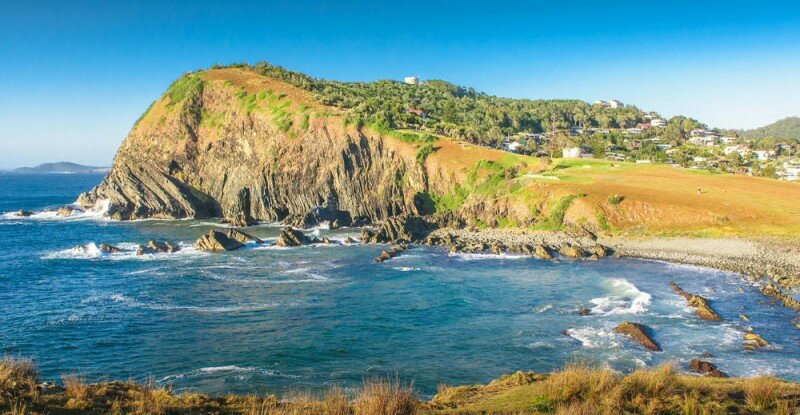History and natural wonders come together for a legendary Macleay holiday.
The wonders of the Macleay region first caught the attention of a tourist way back in 1770, or at least that was the first documented visit.
Captain James Cook voyaged up the east coast and named “Smoakey Cape” writing in his journal “a point or headland, on which were fires that caused a great quantity of smook, which occasioned my giving it the name of Smooky Cape (sic) “.
While Smoky Cape may have been spelt differently, there was no doubt at all about the natural attraction of this stunning length of coast and tourism was already booming in the area just over century after that first distant sighting.
In 1889 it was reported nearby South West Rocks was dealing with an influx of 300 visitors who’d erected up to 60 tents. They were mingling with guests from the nearby Jubilee Guest House, regarded as “one of the best in the colonies”.
Bathing machines were advertised as early as 1885 with “competent lady attendants” supervising. By then, South West Rocks was being described as “’The Manly of the North”.
Today the Macleay Coast’s spectacular beaches and beautiful shoreline are still drawing visitors in their hundreds. From gently rolling waves to pounding surf breaks, the variety and pristine splendour of the region’s beaches make them some of Australia’s best. They are so numerous, it’s never too hard to find a quiet patch if you want to get away from it all.
One of the best places to get a snapshot of the Macleay is from the top of Mount Yarrahappini where on a clear day you can get a panoramic view and see for yourself how the rainforest meets the sea. It’s a good starting point for a leisurely coastal drive, stopping in at the little villages and beaches on the way.
The surrounding hinterland region is probably the true surprise – and delight – of the Macleay Valley Coast. Within minutes of leaving Kempsey you can find yourself in true Australian mountain country with crystal clear creeks, rocky outcrops, towering eucalypts and the warmth of good old fashioned country hospitality.
The Upper Macleay River offers some of Australia’s best bass fishing, while lovers of the great outdoors also come here to camp, bushwalk, explore the restored timber towns and soak up the natural beauty.
Did you know?
Kempsey and the Macleay region are home to three Australian icons:
1. Slim Dusty
David Gordon Kirkpatrick was born in Kempsey and grew up at Melody Ranch at Nulla Nulla near Bellbrook.
Legend has it that Slim Dusty began his performing career by travelling the long route from the family farm at Bellbrook and standing outside the studios of Radio 2MC until the station manager finally gave him a job.
He knew his destiny – he adopted the Slim Dusty name at age 11 and went on to be one of our most successful recording artists, with a professional career spanning 70 years.
Slim’s 1957 smash hit, “The Pub with no Beer” broke so many records it still manages to hold on to a few today.
Today the visitors can follow the Macleay to see Slim’s childhood home at Nulla Nulla near Bellbrook. There is a story board which tells of his life and press a button to hear Slim talk of his memories growing up in this picturesque location.
There is a dirt road through Millbank to a hotel today known as the Pub with No Beer.
2. Akubra hats
A family-owned company tracing its hat-making heritage back to the 1870s, Akubra moved from Sydney to Kempsey in 1974. Australia’s best known hat maker outfitted our servicemen with slouch hats in both World Wars, while Prime Minister Ben Chifley’s Akubras are housed in the National Museum.
There are no visitor tours of the factory, however there is a video and display at the Kempsey Visitor Information Centre. You can buy Akubras from the range at Barsby’s in Smith Street in Kempsey. Barsby’s is one of the few remaining family-owned department stores in existence in regional NSW -well worth a visit in its own right.
Akubra is the key sponsor of the Kempsey Cup on November 8th at the Warwick Park Racecourse.
3. MILO
The drink named after the Greek mythical character of great strength was developed by Nestle as a health tonic for malnourished children during the depression. First produced at Smithtown near Kempsey, Milo debuted at the 1934 Sydney Royal Easter Show and has been a hit with Aussies ever since.
Industrial chemist Thomas Mayne was Milo’s inventor, using industrial food production processes that were cutting edge for their time.
A chocolate syrup is made from cocoa, malted wheat and barley, with liquids evaporated out to create sweet chunks. These are then pummelled into tiny pieces, then sealed in a can.
Nestle’s Smithtown factory, a dairy production site since 1897, still makes Milo today.
While the plant is not open to tourists, you can take a history walk around Smithtown and enjoy hot cup of the chocolate malt drink at the end of a great day of sightseeing.
Learn more about the Macleay Valley Coast: macleayvalleycoast.com.au
Need somewhere to stay? Check out Macleay Valley Coastal Holiday Parks: mvcholidayparks.com.au






